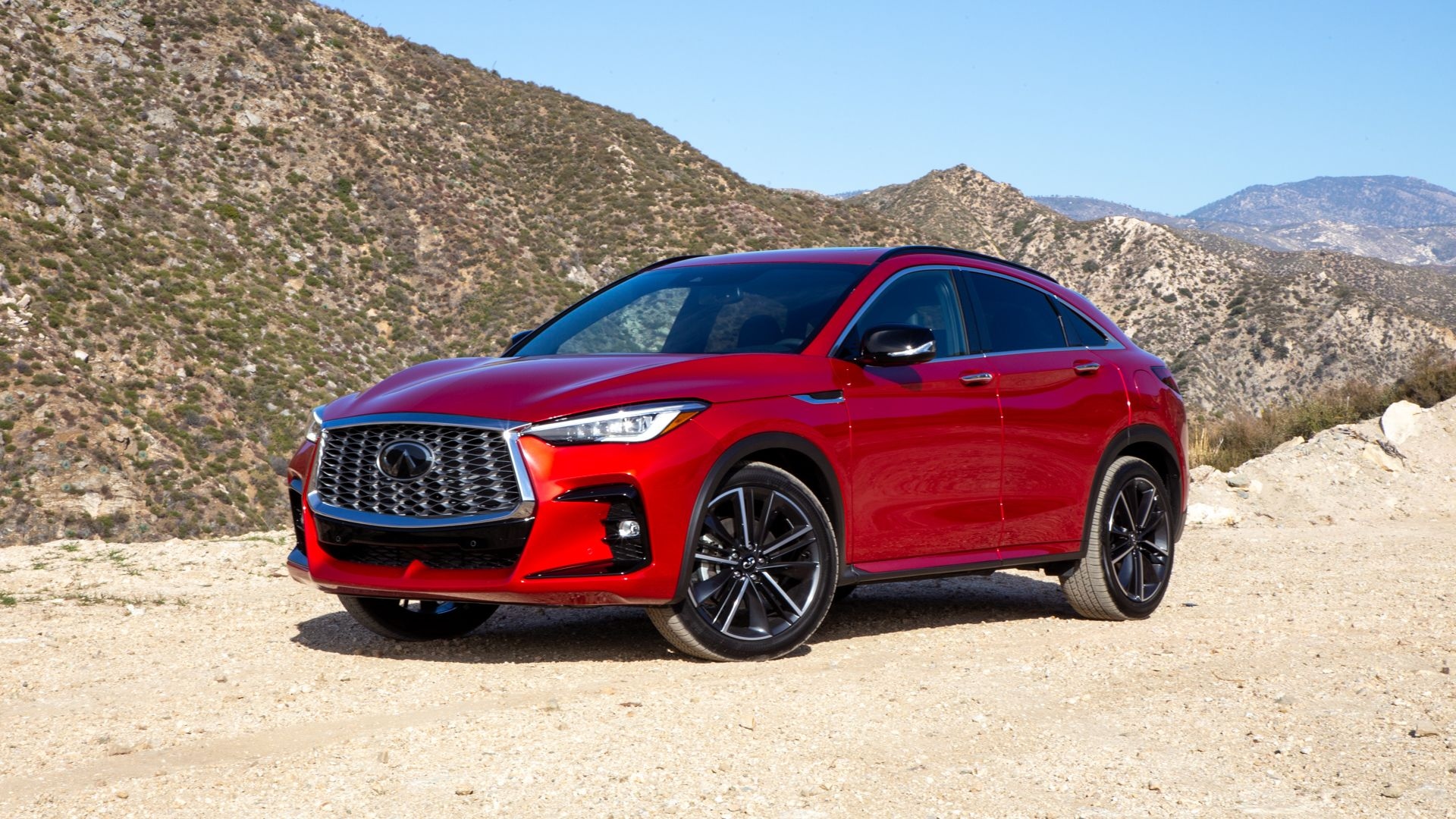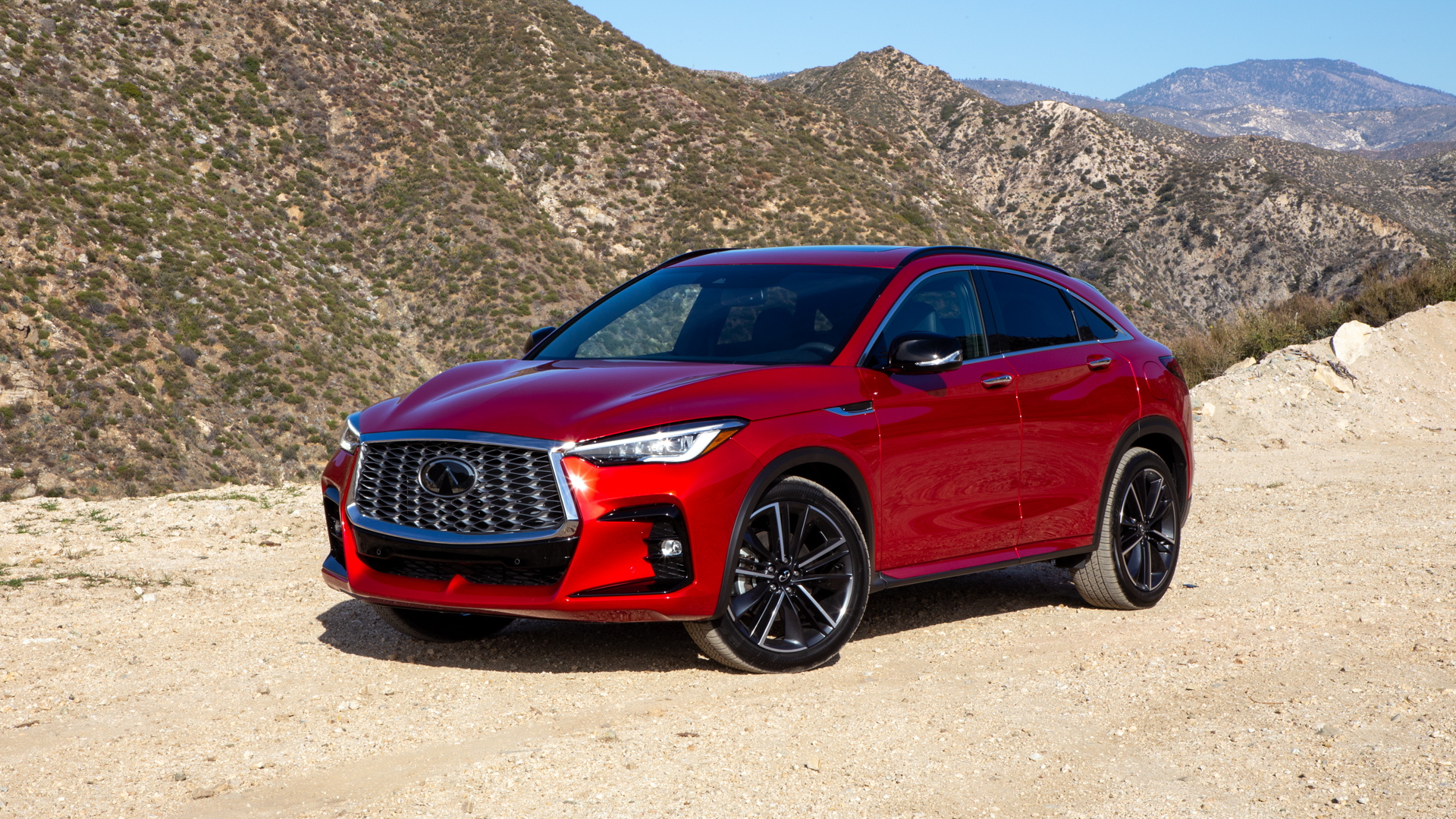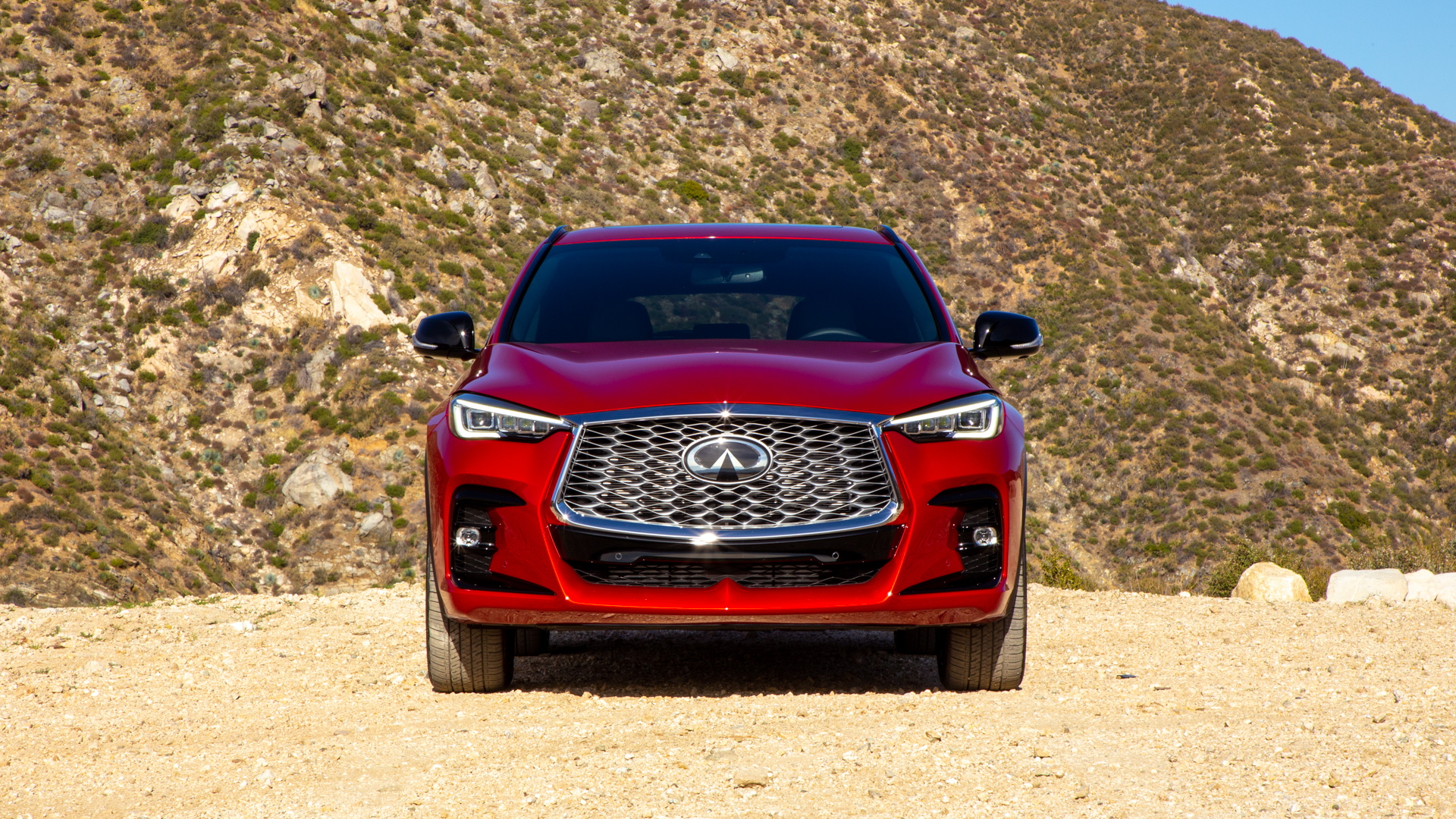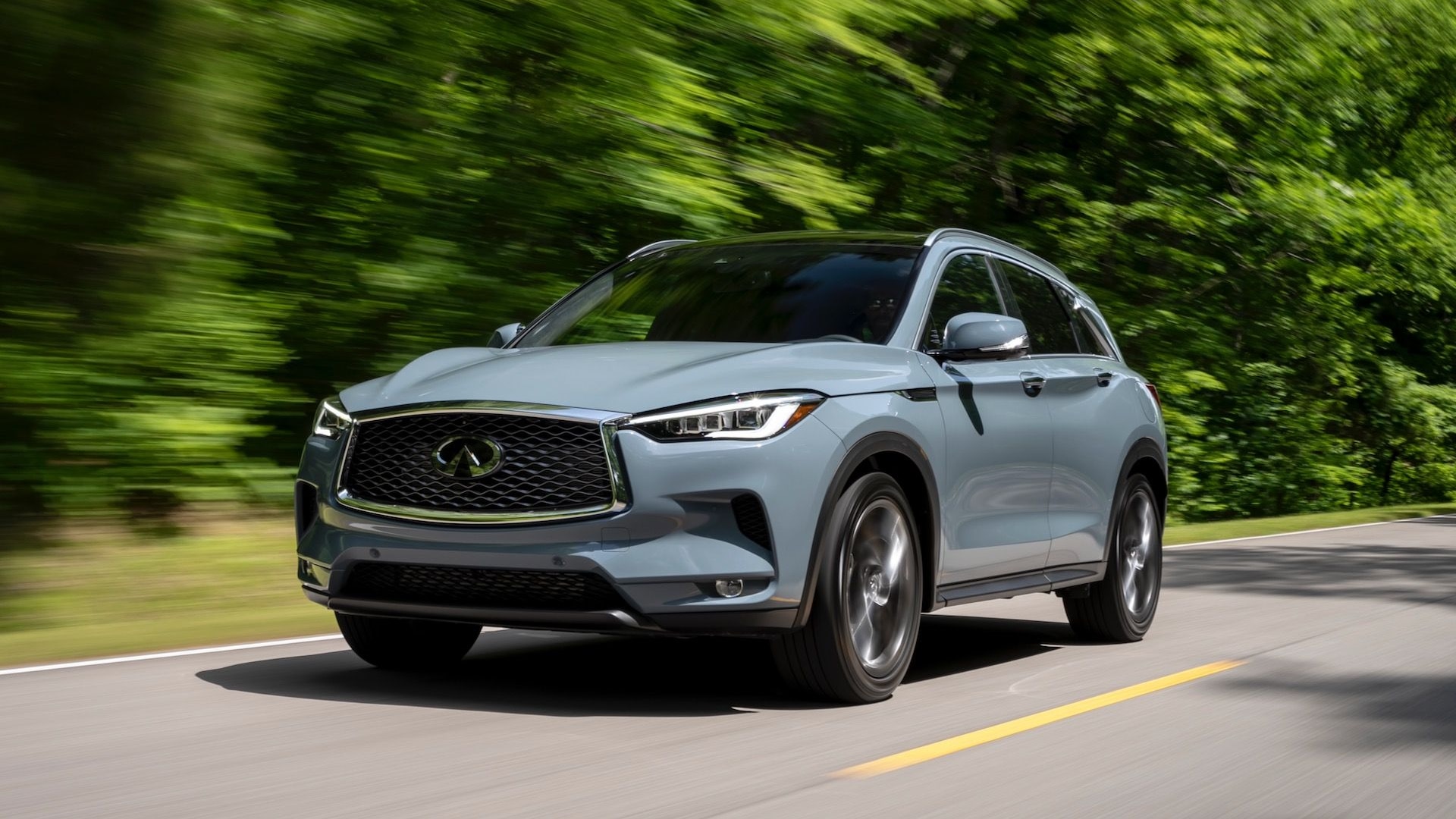The 2022 Infiniti QX55 really catches the eye, even more so when covered in the Sunstone Red paint on the test vehicle that arrived at my apartment enclosed in a trailer. I’m sure passersby on the street were confused by the light show and music that accompanied its arrival, but I was too busy ogling the crossover to notice.
It’s clear that Infiniti pored over the QX55’s exterior details. The gray grille’s wavy pattern is wonderfully intricate, the taillights have 45 individual LEDs in each cluster, subtle curves on the hood add dimension, and the overall shape is elegant and dynamic at the same time. Infiniti was one of the original purveyors of the coupe-esque SUV profile, with the FX that arrived for the 2003 model year, and the QX55 continues that tradition proudly, at least in the looks department.

2022 Infiniti QX55

2022 Infiniti QX55

2022 Infiniti QX55
The rest of what the QX55 has to offer is a mixed bag, especially when it comes to performance. The QX55 shares a powertrain with the closely related QX50, combining a variable-compression 2.0-liter turbo-4 that makes 268 hp and 280 lb-ft of torque with a continuously variable transmission. The QX55 gets all-wheel drive standard across all three of its trim levels (Luxe, Essential, and Sensory), while the QX50 also offers front-wheel drive and additional Pure and Autograph models. Fuel economy is estimated at 22 city, 28 highway, 25 combined mpg, equalling QX50 all-wheel drive models.
For everyday driving, the powertrain feels more than adequate. Infiniti’s variable compression technology is meant to allow the engine to run in a more fuel efficient mode when it can and provide more power when needed. The changeover between these modes is pretty seamless to the driver. Cruising along, then accelerating to get on the highway or pull away briskly from stoplights happens nearly as an afterthought. I noticed no lag or powertrain confusion in these situations.
But take the QX55 onto a canyon road and some of the cracks in the facade start to show. Paddle shifters allow the driver to hold the CVT’s eight pre-programmed gear ratios to keep power on tap but the transmission is still slushier than a conventional automatic. I would be very interested to test this engine strapped to a good dual-clutch 7- or 8-speed automatic; I think that could put the engine’s quick torque output to better use.

2022 Infiniti QX55
My test vehicle was a line-topping Sensory model, which comes with an adaptive steering system that adjusts steering heft based on the situation and filters out vibrations through the steering column. Instead, it filters out almost all of the feel, which left me crying out for more feedback from the wheel. Compounding matters was the QX55’s Active Trace Control system that brakes the inside wheels in corners and allows the driver to take a tighter line. This system also felt very artificial, like the vehicle was figuring out corners on its own, and I was just along for the ride.
As a plus, the QX55 is very quiet in day-to-day driving. Active noise cancellation filters out most of the outside world, though you will get a bit of artificial engine noise that is piped into the cabin somewhat aggressively. The suspension does a good job of isolating occupants as well, giving the QX55 a luxury-grade experience in some respects. Just don’t expect it to be as engaging as its appearance would suggest.

2022 Infiniti QX55

2022 Infiniti QX55

2022 Infiniti QX55
The QX55 interior is also a mixed bag. It features Infiniti’s two-screen multimedia setup that puts a navigation map or phone options on the top 8.0-inch screen, leaving the bottom 7.0-inch screen to handle the rest of the duties. The top screen looks pixelated when using the native multimedia system, but appears much sharper when using wireless Apple CarPlay or wired Android Auto (both standard).
I liked the system when my phone was connected as it allowed me to use the top screen for Google Maps, while the bottom screen remained available to change the satellite radio stations or play with the QX55’s settings without having to put the map away. Nonetheless, the whole setup seems about a generation behind what you get in luxury competitors like the Audi Q5 Sportback and BMW X4.
The Sensory model features real leather upholstery, heated and cooled front seats, and real-wood accents. As daring as the exterior design is, the interior feels much more sedate; nearly everything on the interior on my tester was black minus some chrome trim pieces. I wished for some more pops of color to match the QX55’s bright red exterior.
The back seat is versatile. The second-row seats slide forward and back to open up as much as 38.7 inches of leg room and it reclines, too. Two adults will fit happily, but fitting three across would result in a very tight squeeze at the hips and shoulders (which is true of the other competitors in this class as well).

2022 Infiniti QX55
The QX55’s style does impact its utility. It has 26.9 cubic feet of cargo space behind the rear seat and 54.1 cubic feet with it folded down. In the QX50, those figures are 31.4 and 65.1 respectively.
I experienced a lot of ups and downs during my 24 hours with the QX55.. It seemed like each thing that the QX55 did well was met by a drawback of some kind. The styling is great, but that sloping roofline makes for small rear windows that cut off some rear visibility. The suspension is comfortable and the Q55 offers good isolation on the highway, but is too numb to have any fun on a good road.
The QX55 carries a significant $7,000 price markup over the QX50, with a base MSRP of $47,525, and that only makes these shortcomings more noticeable. My test vehicle stickered all the way up at $58,975 and at that price both the BMW X4 and Audi Q5 Sportback offer better performance and technology. Seven thousand dollars is a lot to pay for style that isn’t matched by substance.








